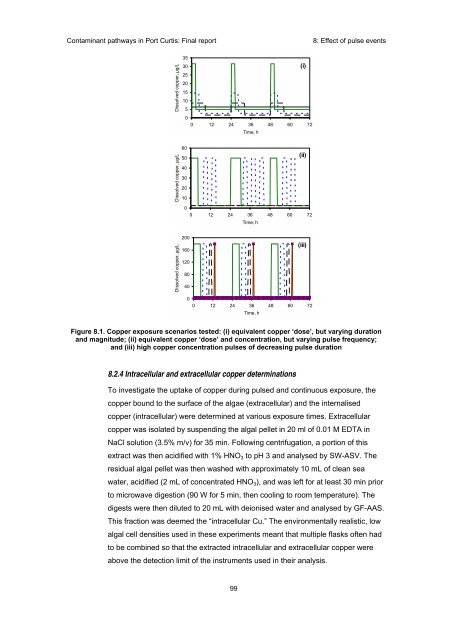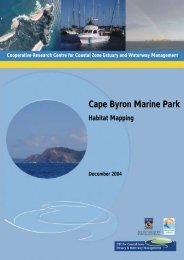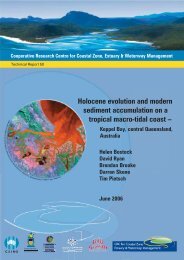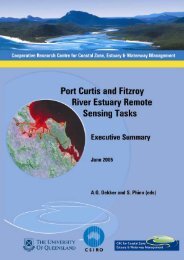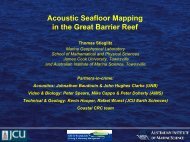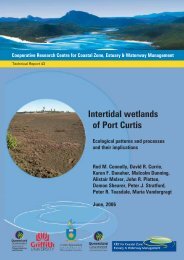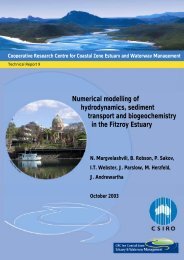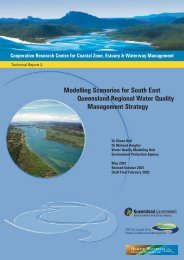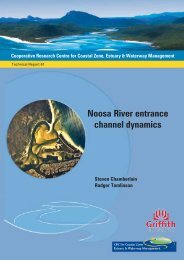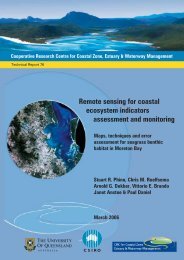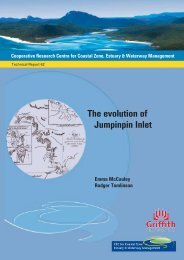Contaminant pathways in Port Curtis: Final report - OzCoasts
Contaminant pathways in Port Curtis: Final report - OzCoasts
Contaminant pathways in Port Curtis: Final report - OzCoasts
You also want an ePaper? Increase the reach of your titles
YUMPU automatically turns print PDFs into web optimized ePapers that Google loves.
<strong>Contam<strong>in</strong>ant</strong> <strong>pathways</strong> <strong>in</strong> <strong>Port</strong> <strong>Curtis</strong>: F<strong>in</strong>al <strong>report</strong>8: Effect of pulse eventsDissolved copper, µg/L3530(i)25201510500 12 24 36 48 60 72Time, hDissolved copper, µg/L605040302010(ii)00 12 24 36 48 60 72Time, hDissolved copper, µg/L2001601208040(iii)00 12 24 36 48 60 72Time, hFigure 8.1. Copper exposure scenarios tested: (i) equivalent copper ‘dose’, but vary<strong>in</strong>g durationand magnitude; (ii) equivalent copper ‘dose’ and concentration, but vary<strong>in</strong>g pulse frequency;and (iii) high copper concentration pulses of decreas<strong>in</strong>g pulse duration8.2.4 Intracellular and extracellular copper determ<strong>in</strong>ationsTo <strong>in</strong>vestigate the uptake of copper dur<strong>in</strong>g pulsed and cont<strong>in</strong>uous exposure, thecopper bound to the surface of the algae (extracellular) and the <strong>in</strong>ternalisedcopper (<strong>in</strong>tracellular) were determ<strong>in</strong>ed at various exposure times. Extracellularcopper was isolated by suspend<strong>in</strong>g the algal pellet <strong>in</strong> 20 ml of 0.01 M EDTA <strong>in</strong>NaCl solution (3.5% m/v) for 35 m<strong>in</strong>. Follow<strong>in</strong>g centrifugation, a portion of thisextract was then acidified with 1% HNO 3 to pH 3 and analysed by SW-ASV. Theresidual algal pellet was then washed with approximately 10 mL of clean seawater, acidified (2 mL of concentrated HNO 3 ), and was left for at least 30 m<strong>in</strong> priorto microwave digestion (90 W for 5 m<strong>in</strong>, then cool<strong>in</strong>g to room temperature). Thedigests were then diluted to 20 mL with deionised water and analysed by GF-AAS.This fraction was deemed the “<strong>in</strong>tracellular Cu.” The environmentally realistic, lowalgal cell densities used <strong>in</strong> these experiments meant that multiple flasks often hadto be comb<strong>in</strong>ed so that the extracted <strong>in</strong>tracellular and extracellular copper wereabove the detection limit of the <strong>in</strong>struments used <strong>in</strong> their analysis.99


